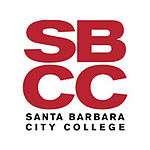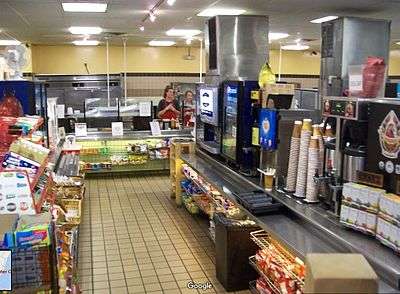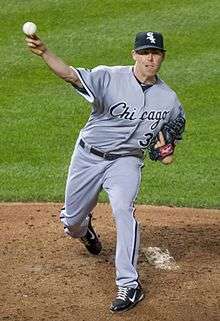Santa Barbara City College
Coordinates: 34°24′23.36″N 119°41′54.73″W / 34.4064889°N 119.6985361°W
 | |
| Type | Public community college |
|---|---|
| Established | 1911 |
| Endowment | $28.1 million[1] |
| President | Anthony Beebe |
| Students | 18,848[2] |
| Location | Santa Barbara, California, U.S. |
| Campus |
Suburban 74 acres (30 ha) |
| Colors | Red and White |
| Affiliations |
Santa Barbara Community College District Western State Conference Southern California Football Association California Community College Athletics Association |
| Mascot | Vaqueros |
| Website |
www |
Santa Barbara City College (SBCC) is a two-year community college in Santa Barbara, California, United States. It opened in 1909 and is located on a 74-acre (30 ha) campus. It offers a wide range of associate degree and certificate programs, as well as transfer programs that provide the first two years of study toward the baccalaureate degree.
SBCC was named co-winner of the 2013 Aspen Institute Prize for Community College Excellence,[3] earning it a #1 national ranking. The college was recognized for its quality and focus in four areas: facilitating underrepresented and minority student success, student learning outcomes, degree completion and transfer rates, and labor market success in securing good jobs after college.
History
Santa Barbara City College was established by the Santa Barbara High School District in 1909, making it one of the oldest community colleges in California. The college was discontinued shortly after World War I, and its work largely taken over by the Santa Barbara State Normal School, which became the Santa Barbara State College, and later, the University of California, Santa Barbara.
SBCC was reorganized by the high school district in the fall of 1946. Called Santa Barbara Junior College from its inception, the Santa Barbara Board of Education formally changed the name to Santa Barbara City College in July 1959. Also in the summer of 1959, the institution moved to its present and permanent location on the Santa Barbara Mesa, former site of the University of California, Santa Barbara. Situated on a 74-acre bluff, the campus overlooks the harbor and Pacific Ocean. Passage of a 1969 construction bond issue and a 1973 land acquisition bond issue ensured that the college would have a single, consolidated Mesa campus.
New developments and programs

The Earth & Biological Sciences Building was completely rebuilt between 2000 and 2002 and is now one of the most technologically advanced science buildings in the state.
The School of Media Arts (SOMA) was established in 2001 to focus on applied communication, visual literacy and digital media. The school covers many areas of interest, including film studies, film production, photography, and computer and multimedia arts.
The music department at features several performance groups, including three jazz ensembles, large and small vocal ensembles, a concert band, and a full symphony orchestra.
The automotive program has been certified by the National Institute for Automotive Service Excellence (ASE) as a master training institution, having met industry standards in all eight of the automotive specialty areas: engine repair, engine performance, heating and air conditioning, electrical systems, automatic transmissions, manual transmission and axle, and brakes and front end.
Santa Barbara City College’s Marine Diving Technologies Program is a recognized program in its field. It is the only community college degree program in the nation which is accredited by the Association of Commercial Diving Educators (ACDE), the International Diving Schools Association (IDSA) and the National Association of Underwater Instructors (NAUI). The program trains and certifies for all levels of SCUBA diving.
The Cancer Information Management Program at Santa Barbara City College offers two types of degrees: An Associate in Science in Cancer Information Management and the Certificate of Completion in Cancer Information Management. It is one of the few Cancer Information Management programs in the nation to currently offer an associate degree which is required to sit for the National Exam to become a Certified Tumor Registrar with the National Cancer Registrars Association starting in 2009.
The student newspaper is named The Channels.[4]
Athletics
A member of the Western State Conference and California Community College Athletic Association, City College offers intercollegiate athletic competition for men in baseball, cross country, and football; for women in softball and water polo; and for men and women in basketball, volleyball, track and field, golf, tennis, and soccer. Santa Barbara City College has won 11 CCCAA State Championship with the Women's Water Polo team being the most recent winner in 2017. Under the leadership of Athletic Director Rocco Constantino in 2017-2018, the Vaqueros finished 10th in the state of California in the NATYCAA Cup Standings, which measures the overall success of the athletic program on the state level. They were the highest ranking Western State Conference school in these standings. This represented the best showing for SBCC in the Cup's history. In 2017-2018, the Vaqueros won a WSC-leading six conference championships. The SBCC Vaqueros soccer and football teams play at the 10,000-capacity La Playa Stadium in Santa Barbara.
A number of SBCC alumni have gone on to play professional sports in America. This group is highlighted by Jesse Orosco, Dylan Axelrod, Delwyn Young and Gary Woods (Major League Baseball), Larry Moriarty (National Football League) and Don Ford (National Basketball Association). Orosco is a member of the CCCAA Hall of Fame, along with former SBCC coaches and administrators Pat Moorhouse and Bob Dinaberg.
In popular culture
It was rumored that two students in the 1960s went blind from staring at the sun while under the influence of LSD.[5] Santa Barbara High School Chemistry teacher Ted Pachen even perpetuated the myth to his class at least as late as the early 1980s.
Notable people
Notable alumni
- Jaime Ambriz, retired professional soccer player
- Ron Anderson, NBA
- Dylan Axelrod, Major League baseball player
- Eion Bailey, American actor
- David Crosby, American folk rock musician
- Douglas H. Evans, American author and fire protection engineer
- Phillip Gonyea, drummer for Los Angeles heavy metal band Before The Mourning and former percussionist for alternative rock band Against All Will
- Ben Howland, American basketball coach of the UCLA Bruins
- James Kiffe, professional soccer player
- Ozzy Lusth of Survivor: Cook Islands and Survivor: Micronesia
- Randolph Mantooth, American actor, writer, and producer
- Airin Older, bassist of Sugarcult
- Jesse Orosco, major league baseball record-holder for career pitching appearances
- Katy Perry, American singer/songwriter
- Elliot Rodger, perpetrator of the 2014 Isla Vista killings[6]
- Mark Andrew Smith, graphic novelist
- Matthew Landy Steen, American political activist, co-founder Weather Underground
- Das Williams, California State Assembly member
- Delwyn Young, baseball player for the Los Angeles Dodgers
- Mansour bin Zayed Al Nahyan, deputy prime minister of the United Arab Emirates and minister of presidential affairs
Notable faculty
- Kathryn Ish, acting teacher[7]
References
- ↑ As of February 5, 2013. "U.S. and Canadian Institutions Listed by Fiscal Year 2012 Endowment Market Value and Percentage Change* in Endowment Market Value from FY 2011 to FY 2012" (PDF). 2013 NACUBO-Commonfund Study of Endowments. National Association of College and University Business Officers. Retrieved January 15, 2014.
- ↑ http://datamart.cccco.edu/Students/Enrollment_Status.aspx
- ↑ The Aspen Institute. The 2013 Aspen Prize for Community College Excellence, 2013. http://www.aspeninstitute.org/sites/default/files/content/upload/AspenPrize_2013FINAL.pdf Retrieved 02-06-2014.
- ↑ The Channels
- ↑ David Mikkelson, LSD Users stare at Sun.
- ↑ http://abclocal.go.com/three/kabc/kabc/My-Twisted-World.pdf
- ↑ "Actor, director Kathryn Ish dies at 71". Variety. 2008-01-08. Retrieved 2008-01-10.
